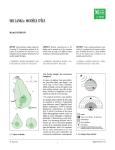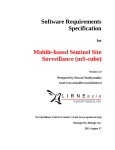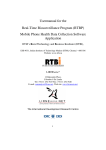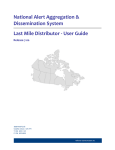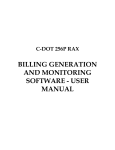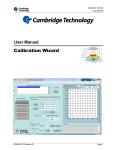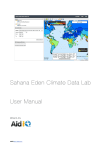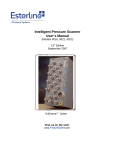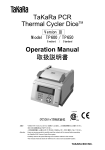Download Software Requirements Specification for Sahana Agasti
Transcript
Software Requirements Specification for Sahana Agasti CAP Broker ~ Working Document ~ Version 1.0 Prepared by Tharaka Wilfred and Nuwan Waidyanatha 2011 December 10 Revision History Name Date Reason For Changes Version EDXL-CAP Sahana Agasti SRS Version 1.0 Table of Contents 1 Introduction............................................................................................................................................5 1.1 Purpose......................................................................................................................................5 1.2 Document Conventions..............................................................................................................6 1.3 Intended Audience and Reading Suggestions............................................................................6 1.4 Product Scope............................................................................................................................6 1.5 References.................................................................................................................................7 2 Overall Description.................................................................................................................................8 2.1 Product Perspective...................................................................................................................8 2.1.1 Context of SABRO.......................................................................................................8 2.1.2 Context of FF................................................................................................................8 2.2 Product Functions......................................................................................................................9 2.3 User Classes and Characteristics..............................................................................................13 2.4 Operating Environment............................................................................................................13 2.4.1 Software Environment................................................................................................13 2.4.2 Hardware Environment...............................................................................................14 2.5 Design and Implementation Constraints..................................................................................14 2.5.1 Automation issues.......................................................................................................14 2.5.1.1 Sinhala Text To Speech (TTS)......................................................................14 2.6 User Documentation................................................................................................................14 2.7 Assumptions and Dependencies...............................................................................................15 3 External Interface Requirements...........................................................................................................15 3.1 User Interfaces.........................................................................................................................15 3.1.1 FF Administrator User Interface-................................................................................15 3.1.2 2N modem administration User Interface...................................................................15 3.1.3 FF Voice Menu...........................................................................................................16 3.2 Software Interfaces..................................................................................................................17 4 System Features....................................................................................................................................19 4.1 Object Oriented Model illustration..........................................................................................19 4.1.1 SABRO User Cases....................................................................................................19 4.1.2 ER Diagram for Sahana CAP.....................................................................................21 4.1.3 Class Diagram for Sahana CAP..................................................................................22 4.1.4 Alerting Sequence.......................................................................................................23 4.2 Alerting user operating picture................................................................................................24 4.2.1 Description and Priority..............................................................................................24 4.2.2 Stimulus/Response Sequences....................................................................................24 4.2.3 Functional Requirements............................................................................................24 4.3 Author CAP message...............................................................................................................25 4.4 Delivery method: IVR.............................................................................................................25 4.4.1 Description and Priority..............................................................................................25 4.4.2 Stimulus/Response Sequences....................................................................................25 4.4.3 Functional Requirements............................................................................................25 4.5 Publish voice-text file..............................................................................................................26 Wilfred and Waidyanatha www.llirneasia.net Page 2 of 34 EDXL-CAP Sahana Agasti SRS Version 1.0 4.5.1 Description and Priority..............................................................................................26 4.5.2 Stimulus/Response Sequences....................................................................................26 4.5.3 Functional Requirements............................................................................................26 4.6 Create audio alert file...............................................................................................................27 4.6.1 Description and Priority..............................................................................................27 4.6.2 Stimulus/Response Sequences....................................................................................27 4.6.3 Functional Requirements............................................................................................27 4.7 Upload to CAP Resource element............................................................................................27 4.7.1 Description and Priority..............................................................................................27 4.7.2 Stimulus/Response Sequences....................................................................................27 4.7.3 Functional Requirements............................................................................................27 4.8 Upload to FF New Alerts menu...............................................................................................28 4.8.1 Description and Priority..............................................................................................28 4.8.2 Stimulus/Response Sequences....................................................................................28 4.8.3 Functional Requirements............................................................................................28 5 Other Nonfunctional Requirements......................................................................................................28 5.1 Performance Requirements......................................................................................................28 5.2 Safety Requirements................................................................................................................28 5.3 Security Requirements.............................................................................................................29 5.4 Software Quality Attributes.....................................................................................................29 5.4.1 Adaptability................................................................................................................29 5.4.2 Availability.................................................................................................................29 5.4.3 Correctness.................................................................................................................29 5.4.4 Flexibility...................................................................................................................30 5.4.5 Interoperability...........................................................................................................30 5.4.6 Maintainability...........................................................................................................30 5.4.7 Portability...................................................................................................................30 5.4.8 Reliability...................................................................................................................30 5.4.9 Robustness..................................................................................................................30 5.4.10 Usability...................................................................................................................30 5.5 Business Rules.........................................................................................................................31 6 Other Requirements..............................................................................................................................31 List of Figures Figure 1: Work flow encapsulating FF and CAP.........................................................................................9 Figure 2: Alerting data flow diagram.........................................................................................................11 Figure 3: The state transition diagram to listen a message service [8].......................................................16 Figure 4: Draft Voice Menu Tree..............................................................................................................17 Figure 5: Sahana-Agasti FF Software Interfaces Overview ......................................................................18 Figure 6: SABRO use cases for issuing voice-alerts..................................................................................20 Figure 7: SABRO entity relationship diagram for voice-alerting...............................................................21 Figure 8: SABRO Class Diagram for voice-alerting..................................................................................22 Figure 9: Proposed Sarvodaya incident communication procedure sequence diagram..............................23 Wilfred and Waidyanatha www.llirneasia.net Page 3 of 34 EDXL-CAP Sahana Agasti SRS Version 1.0 Figure 10: map of all alerts (e.g. landslides, train derailment, missing people).........................................24 Index of Tables Table 1: Typographical conventions............................................................................................................6 Table 2: Overview of System Functions......................................................................................................9 Table 3: Explanation of Data-flow Diagram Elements in relation to the flood example............................12 Table 4: Explanation of User Classes and Characteristics Elements..........................................................13 Table 5: Explanation of Use Cases (Figure 6) for general SABRO...........................................................20 Table 6: Necessary and sufficient CAP elements for voice-alerts..............................................................31 Wilfred and Waidyanatha www.llirneasia.net Page 4 of 34 EDXL-CAP Sahana Agasti SRS Version 1.0 1 Introduction The design of the software discussed in this document follows from the action research [1]: “Feasibility study to enable Freedom Fone (FF) with voice-based Emergency Data Exchange (FF4EDXL)”. Evidence points to people in developing countries, like Sri Lanka, to be more accustomed to voice-based telephony services opposed to text-based applications [2]. Therefore, the research aims to find ways to enable interactive voice-based systems for emergency communications; especially, with the ability to interchange categorical crisis information with other emergency management systems. 1.1 Purpose Lanka Jathika Sarvodaya Shramadana Sangamaya is a community-based organization active across ~15000 villages in Sri Lanka. They frequently engage in disaster management activities. Their recent past experiences are: 2011 floods in the east, 2011 floods in the central and western provinces, 2011 landslide in the hill country, 2009 war in the north, so and so forth. The system requirements proposed in this document are to meet Sarvodaya's emergency information reporting needs but generalizing it to cover a broader scope of incident reporting and management FF is a tool which was build for telephone communication using interactive voice menus, voice messages, SMS and polls [3]. Given the research problem, the idea is to enable FF for communicating emergency data, between field operatives (CERT members) and incident management centers (HIH), over voice-based platforms. Sahana is a free an open source software designed for disaster management [4]. It has two main branches: Agasti and Eden; where Agasti is developed with PHP and Eden is developed with Python programming languages. The specifications in this document would follow a general approach but is mainly geared for enhancing and building the Sahana Agasti Common Alerting Protocol and Common (CAP) Alerting functional components. Sahana Alerting Broker (SABRO) was, firs, developed by the HazInfo [5] and Real-Time Biosruveillance Program (RTBP) [6] action research projects. The module is capable of issuing alerts over SMS (short-text), Email (long-text), and Web (long-text). This SRS takes in to considerations the lessons learned from the RTBP action research [6, 10]. In this project, FF4EDXL, we will improve the SABRO to exchange voice-text messages with FF for delivering voice-based alerts over the FF IVR. The goal is to integrate FF and Sahana, with FF acting as an interface between the Community Emergency Response Team (CERT) and Hazard Information Hub (HIHO) for sending/receiving alerts and situational awareness messages. We shall follow the Emergency Data Exchange Language Common Alerting Protocol (EDXL-CAP) standard [7] as a guide in recommending the design and requited software changes to Sahana and FF. Wilfred and Waidyanatha www.llirneasia.net Page 5 of 34 EDXL-CAP Sahana Agasti SRS Version 1.0 1.2 Document Conventions These are the standards or typographical conventions of this document. Table 1: Typographical conventions Typeface Indicates Example bold Topics, Sub topics, 1 Introduction, 1.2 Document Conventions italics Parameters or variables whose actual names or values are to be supplied by the user. To introduce new terms. The attribute name can be specified with or without leading and trailing double underscore characters. <element> </element> XML tags <value> value </value> Acronyms Abbreviation or Acronyms forms of standards EDXL- CAP, CAP 1.3 Intended Audience and Reading Suggestions This software requirement specification is intended for • The LIRNEasia researchers and development team. • Sarvodaya disaster managers and other Sarvodaya resource persons • Software developers and domain experts of the Sahana Free and Open Source Software (FOSS) community. • FF voice-based system developers and community. • Subsequent, third-party, researchers, implementers, or developers, working in disaster management; specifically emergency communication. This document contains information about EDXL- CAP, Sahana and FF. To get a comprehensive idea of this requirement specification, the reader is encouraged refer to the SRS developed for the RTBP [6]. 1.4 Product Scope Objectives: ● Study the Sarvodaya emergency-related information communication needs; specifically, the alerting requirements, immediate, before and after the disaster impact ● Adopt the EDXL-CAP incident alerting data standard for enabling system interoperability and information consistency between SABRO and FF ● Map the Sarvodaya information needs to EDXL-CAP format ● Implement the EDXL-CAP based Sarvodaya information needs in FF as an interface for sending voice-based alerts. Wilfred and Waidyanatha www.llirneasia.net Page 6 of 34 EDXL-CAP Sahana Agasti SRS Version 1.0 Enhance the Sahana-Agasti SABRO module to adhere to EDXL-CAP Interface the FF information collection implementation with Sahana by developing procedures for converting the text content to voice and managing the information in Sahana ● Provide GUIs for Sarvodaya incident managers to view and manipulate the alerts ● ● Benefits ● User interface to receive voice alerts does not require specialized software or equipment, simply any mobile phone or fixed phone will work ● People can use their own handsets and system can piggy back on existing communications infrastructure ● Very minimal training required as people are accustomed to handling voice telephony; some training will be required how to interpret the voice alerts; i.e. get accustomed to standardized terminology and alerting sequence ● Adoption of EDXL-CAP allows for data exchange across information management systems ● Integrating with Sahana provides a broader utility of the information that can be correlated with other emergency information ● Positions FF's utility in the disaster management space Advantage of enhancing Sahana with voice based information exchange, with the help of FF, will overcome the language and literacy barriers when reaching out to the millions of people living on rural arias, in developing countries like Sri Lanka. Absence, of interactive voice applications for sending information forces organizations like Sarvodaya to revert to paper-based systems. The final goal of this project will provide a platform for disaster management organizations like Sarvodaya to, improve the effectiveness managing disasters by using an end-to-end electronic system with digitized data; thus, minimizing the need for paper. 1.5 References [1] LIRNEasia project proposal (2011). Feasibility study to enable Freedom Fone with voicebased Emergency Data Exchange (FF4EDXL), web: http://lirneasia.net/projects/2010-12research-program/ff4edxl/ [2] Tharaka Wilfred and Nuwan Waidyanatha. (2011). Sarvodaya Training Workshop Report, Survey Results web: http://lirneasia.net/wpcontent/uploads/2011/09/training_workshop_report_Sep_2011.pdf [3]Freedom Fone website- http://www.freedomfone.org/ [4] Sahana disaster management system website: http://www.sahanafoundation.org/ [5] Gordon Gow, Peter Anderson, and Nuwan Waidyanatha (2008). Common Alerting Protocol Message Broker for Last-Mile Hazard System in Sri Lanka: Essential Components, web: http://idl-bnc.idrc.ca/dspace/bitstream/10625/42331/1/129771.pdf Wilfred and Waidyanatha www.llirneasia.net Page 7 of 34 EDXL-CAP Sahana Agasti SRS Version 1.0 [6] Gordon Gow and Nuwan Waidyanatha (2009). CAP Alerting For Sahana Messaging Module version 1.0: http://lirneasia.net/wp-content/uploads/2009/05/Sahana-CAP-Msg-Modv0.2.pdf [7] OASIS (2010), Common Alerting Protocol Version 1.2: http://docs.oasisopen.org/emergency/cap/v1.2/CAP-v1.2-os.pdf [8] Freedom Fone, Non-technical User Guide, Freedom Fone Pictus Lupinus 1.5.2, March 2010, web: http://www.freedomfone.org/files/guides/FF_1.5.2_non_tech_guide.pdf [9] Viraj Welgama, Interview, University of Colombo School of Computing, Language research center, consulted 2011 August 05. [10] Mifan Careem, Damendra Pradeeper, Kaluarachchi, Gordon Gow, Ganesan M. and Waidyanatha (2010). IEEE-ICCIA 2 Overall Description 2.1 Product Perspective 2.1.1 Context of SABRO The SABRO already contains a messaging/alerting module, which can be used to disseminate alerts and situational awareness information. The types of information that can be disseminated through this module are the hazard event, description, message priority, instructions, onset date & time, message effective/expire date & time, etc and then send those alert to the targeted persons in the applicable areas. The alert message would activate the first-responders like the Sarvodaya CERT and HIHO to respond to hazard events. 2.1.2 Context of FF The FF IVR system can exchange voice-base audio information through telephone networks. This can be used to relay the CAP messages through the FF interactive voice system. The interactive voice response system would either push the voice messages to the intended recipients as a voice call or host the audio file for the first-responders to access in order to supplement a fuller description of the alert they received via SMS. Figure 1 shows the interaction of the various hardware and software components that are integrated to provide the required solution. Wilfred and Waidyanatha www.llirneasia.net Page 8 of 34 EDXL-CAP Sahana Agasti SRS Version 1.0 Figure 1: Work flow encapsulating FF and CAP 2.2 Product Functions The major functions of the entire system are listed in Table 2. Figure 2 provides a data flow diagram of the various stages of the execution process. Table 2: Overview of System Functions No Function Description 1 Create Template For the convenience of the message creators and issuers, the implementers will, first, create CAP message templates that are essentially reusable CAP messages. 2 Create CAP message Authorized persons at Sarvodaya HIH will create a CAP message using SABRO. The user will select the appropriate template, then fill in the required information with respect to the event of interest 3 Save CAP message The message is first saved to the database. That would Wilfred and Waidyanatha www.llirneasia.net Page 9 of 34 EDXL-CAP Sahana Agasti SRS Version 1.0 generate a EDXL-CAP file in the system. 4 Select recipients The user must first select the set of intended recipients from the list of groups or individuals; this is mainly for Closed User Group (CUG) alerting. 5 Select message delivery method The HIHO would, typically, select, SMS, Email, Web, and IVR as message delivery methods. For the purpose of voice alerting, the message sender would select SMS and IVR. That would produce a short text SMS and the voice-text content for producing an audio message. 6 Create CAP voice message The HIHO will retrieve the respective CAP voice-text message, then translate that text to the local language: Sinhala and Tamil. Thereafter, use a tool like Audacity to record the voice alert to produce a MP3 file. 7 Upload MP3 The CAP voice message, in the form of a MP3 file, is uploaded to the FF system under the alert menu: new alert under a sub menu labeled with the message id and headline. 8 Issue Alert After the voice alert is staged in FF, the HIHO would issue the SMS alert. The SMS text would contain the call back number, which the recipients will use to call FF to receive the voice message in the local language. 9 Acknowledge receipt Once the recipient has received the SMS text and heard the voice alert, and is clearly understands the alert message, they will send an acknowledgement in the form of a text message. The message would contain the following two words: ack yes (to acknowledge with a positive response) or ack no (to acknowledge with a negative response). 10 Acknowledgement report The HIH can view the polling function report for acknowledgements to determine those recipients who did or did not get the message and also those recipients who will respond or not. Wilfred and Waidyanatha www.llirneasia.net Page 10 of 34 EDXL-CAP Sahana Agasti SRS Version 1.0 Figure 2: Alerting data flow diagram Wilfred and Waidyanatha www.llirneasia.net Page 11 of 34 EDXL-CAP Sahana Agasti SRS Version 1.0 The following - Flood in Batticaloa - scenario is used as an example to explain the Data flow diagram in Figure 2. This scenario not intended to be an exhaustive example of this system usage and may not fully reflect actual practices. Flood in Batticaloa Heavy rains in Batticaloa district has caused flash floods. All residences are inundated with flood waters. They need to be evacuated and provided temporary shelter.. Table 3: Explanation of Data-flow Diagram Elements in relation to the flood example. Step Explanation Monitor Event Heavy Rains in Batticaloa district, Flood has occurred and a Sarvodaya emergency management volunteer has reported the incident to the Hazard Information Hub (HIH). Confirm Disaster HIH will inquire from the District coordinator or authorized person about disaster details to confirm. Create Text Alert HIH-Monitor sends a message, using SABRO, requesting CERT and HIHO to resume duties immediately. Produce voice-text alert That message is used to generate a voice-text-message. Record audio file The HIH-Monitor use the voice-text message to record a voice audio file. Upload Voice alert Then upload that file to the “new alert” menu item of FF. Issue SMS alert to the users A SMS-short-text of the alert is disseminated, intended as a wake-up function, but the message will carry minimal information with a call back number User access the Voice alert and play message The CERT and HIHO will call FF to listen to the audio alert message created in the local language. Acknowledgement from user Once the message is heard the CERT and HIHO will send a SMS to the same phone number as “ack yes” or “ack no” based on their choice. Get Acknowledgement Confirm that member received a text message and heard audio file. report Wilfred and Waidyanatha www.llirneasia.net Page 12 of 34 EDXL-CAP Sahana Agasti SRS Version 1.0 2.3 User Classes and Characteristics Table 4: Explanation of User Classes and Characteristics Elements. User Class Privileges Resource Persons Administrator Add, Edit, Disable Linux server and database users and assign full access to the software and operating system System administrator Implementors Add, Edit, Disable CAP templates, set user group privileges The CAP specialists defining the CAP profile and implementing the operating procedures. HIHO Create, Edit, and Issue CAP messages. HIH Operators, usual authorized personnel in charge of creating and issuing CAP messages HIH-Supervisor Verify and authenticate sending of Digitally signs CAP CAP messages messages, verifies and authenticates sending of messages, CAP message would carry his/her name in the <senderName> element CERT Receive CAP messages and submit acknowledgements to the system Community Emergency Response Team members who receive and acknowledge alerts 2.4 Operating Environment 2.4.1 ● ● ● ● ● ● Software Environment Operating system: Ubuntu 10.04 (LTS) or better Third party application: ○ Freedom Fone 2.0 or better ○ Sahana Agasti-phase2 Databases: MySQL 5.1 or higher LAMP (Linux, Apache, MySQL, php) web hosting platform Mail Transfer agent: Postfix Web server: Apache 2.0 Wilfred and Waidyanatha www.llirneasia.net Page 13 of 34 EDXL-CAP Sahana Agasti SRS Version 1.0 2.4.2 Hardware Environment ● ● ● ● ● ● ● Memory: 2GB RAM or better Processor: 2GHz dual core processor or better Disk Space: 40GB hard-drive or higher Sound card: Wireless cards: USB wireless adapters or LAN card: 2N OfficeRoute 2.5 Design and Implementation Constraints At this stage of the research, full and complete integration of EDXL-CAP is not expected. Integration is done just for finding out what are the most appropriate and basic elements or components need to be added. The outcome of this action research will help to get a better understand of integration of EDXL-CAP message stranded between SABRO and FF. 2.5.1 Automation issues We did some background research to understand the availability of TTS and STT for local languages Sinhala (si) and Tamil (ta). The si and ta language TTS would be handy in simply typing or supplying text in to FF, instead of a human having to record the audio clips. The STT is more important for situational reporting; where as TTS is necessary for alerting. 2.5.1.1 Sinhala Text To Speech (TTS) The system is based on the Festival speech synthesizer, developed at University of Edinburgh. The system can run as both installed application and portable application. After the installation, we can configure it as the system sound. Then from program interface or through command line we can feed Sinhala sentence or Sinhala text file, and voice output can be received. The input sentences should be on, Unicord encoding. Improvement is going on for handling punctuation marks, controlling the voice tone and voice level, improving voice softness and clearness. The system is functioning with considerable accuracy and can be used practically [9]. 2.6 User Documentation Following user manuals will be created with the project continuation. Sarvodaya Community Disaster Management Center Hazard Information Hub System Administrator Quick Reference Guide ● Hazard Information Hub Operator (HIHO) Training Manual- Session 1, Session 2 ● Community Emergency Response Team (CERT) Training Manual. ● Wilfred and Waidyanatha www.llirneasia.net Page 14 of 34 EDXL-CAP Sahana Agasti SRS Version 1.0 2.7 Assumptions and Dependencies ● ● ● ● ● ● ● Interactions between FF and the 2N Modem, occasionally, are interrupted due to cron jobs that fail to execute or are disabled by other software. FF instructions for navigating the menu and selecting the correct functional menu item must be precise and concise; else the users tend to get confused with the required actions. The phone numbers used for the project are not numbers that can be easily remembered, such as 911 or 112. They are general numbers but we assume that users will add them to their phone-book. It is expected that the caller has sufficient credit (especially pre paid mobile connections) to connect with FF. However, a feature with FF to call the intended message recipient may be far more useful in eliminating some tariff related uncertainties. The system should support all telecommunications carriers. Interconnectivity should be available between these carriers. For business continuity and sustenance it is assumed that Sarvodaya will use FF and Sahana for other day-to-day activities. There is no authenticate to access FF at present. Anyone can call to the system. Open system would be vulnerable with prank calls and untrained or unauthorized personnel supplying/accessing emergency information. 3 External Interface Requirements 3.1 User Interfaces 3.1.1 FF Administrator User Interface- FF administrator has a web based GUI for software administration purposes. Main components of the GUI are mentioned here. Dashboard- Contain functionalities for control the system’s software and hardware and start and stop major components in following sub menus. Health- Current status of the telephony applications. Settings- Software components of the system, databases, web server, FreeSwitch etc GSM Channels- Connected GSM gateways. Logs- for debugging any system faults. IVR Center-Voice Menus- Contain functionality to build variety of customized audio files such as welcome messages, instructions how to navigate etc. and text messages. Administrator can create multiple voice menus and edit or delete a Voice Menu at anytime 3.1.2 2N modem administration User Interface The 2N® OfficeRoute/2N® VoiceBlue Enterprise gateways provide a direct interconnection of VoIP, GSM and UMTS (UMTS only in 2N® OfficeRoute) networks with the support of SIP and H.323 signaling protocols. contains six sub-menus - network configuration, serial console settings, command line configuration, calls and device states, reboot and settings of VRRP and Wilfred and Waidyanatha www.llirneasia.net Page 15 of 34 EDXL-CAP Sahana Agasti SRS Version 1.0 DHCP. After entering the required information you will be able to use a high speed data Internet connection, make outgoing and incoming calls to GSM and UMTS networks and benefit from the PBX features. 3.1.3 FF Voice Menu The FF Content service offers field users to listen to the FF. The filed user is connected to a voice menu created by the administrator. The voice menu provides instructions how to use the service. Figure 3 shows the state transition diagram of the FF actions and Figure 4 shows a prototype implementation of the voice menu for enabling such a process.. ● Listen to each disaster and Exit. Figure 3: The state transition diagram to listen a message service [8] Content a Message Service 1. Welcome to the disaster management service, Press 1 for Sinhala, Press 2 for Tamil and Press 3 for English. Enter your pin number. 2. Select the suitable actions: listen to the alert press 1, to create report press 2, to survey press 3. 3. Select the appropriate Option here, If you are a HIHO member then press 1 and If you are a CERT member then press 2. 4. Invalid option. Please try again. 5. Time out. Wilfred and Waidyanatha www.llirneasia.net Page 16 of 34 EDXL-CAP Sahana Agasti SRS Version 1.0 6. Select the disaster event that you want to listen. 7. Listen to the selected voice message. 8. Thank you and Goodbye. Figure 4: Draft Voice Menu Tree 3.2 Software Interfaces This section describes the specific software component interfaces that the FF and Sahana system operates (see Figure 5) . Ubuntu V10.04 Operating System - is a popular free and open source OS based on Linux Debian platform, http://www.ubuntu.org/ CAP V1.2 - is an alerting content standard developed by OASIS [7]. It is based on XML, which allows for interoperability of emergency information. Wilfred and Waidyanatha www.llirneasia.net Page 17 of 34 EDXL-CAP Sahana Agasti SRS Version 1.0 Freedom Fone V2.0- The FF interacts with the user through a voice menu. When a incident happens, authenticated users will call FF and they will be connected to the GSM gateway. The GSM module is connected to the FreeSWITCH which routes the incoming and outgoing voice calls. The FF integrated dispatcher listens to FreeSWITCH events. When an FreeSwitch event happens it will be captured by the dispatcher, the event is converted to an internal FF XML format. The XML event is then processed, parsed and inserted in the SQL database. The FF administrative user interface is a web based interface where users can control FF connected software and hardware. Figure 5: Sahana-Agasti FF Software Interfaces Overview Sahana Agasti - is the main user interface to interact with this whole system. Alerting/ Messaging Module is the main communicative root of CAP messaging. It is used to send SMS, e-mail alerts and/or messages to various groups and individuals before, after and during a disaster to interact with field users like CERT members, HIHO members and other authorized users. It also provides a convenient way of grouping mobile phone numbers and e-mail addresses. Free switch- FreeSWITCH is a scalable open source cross-platform telephony platform designed to route and interconnect popular communication protocols using audio, video, text or any other form of media [8]. FF uses FreeSWITCH in-build modules such as, Interactive voice Wilfred and Waidyanatha www.llirneasia.net Page 18 of 34 EDXL-CAP Sahana Agasti SRS Version 1.0 response (IVR), TTS/ASR (text to speech/automatic speech recognition) and Public switched telephone network (PSTN) interconnection ability. It routes incoming/outgoing calls and SMS. Interacts with the FF inbuilt dispatcher to feed data to the FF application layer MySql - is a popular free and open source relational database, http://www.mysql.com/. 4 System Features The system features discussed in this section are mainly for authoring an alert and then delivering it as an voice alert through the FF system The process requires that a voice-text message (text) is generated in human readable form. That message is then converted to an audio message by human; i.e. reading out the voice-text. • • • • • User should log in to Sahana interface through http://www.samanathetha.lk/sahana/ using their user name and password, Then user can see all the Sahana modules in that page as such as Disaster Preparedness, Massaging/Alerting, Biosurveillance, etc. The aim is to go to the messaging/alerting module to interact with this system according to the incident. First user has to select the messaging/alerting module. Messaging module is the main communicative root of the Sahana system. It is used to send SMS, e-mail alerts and/or messages to various groups and individuals before, after and during a disaster. It also provides a convenient way of grouping mobile phone numbers and e-mail addresses. 4.1 Object Oriented Model illustration 4.1.1 SABRO User Cases Actors CERT: Sarvodaya disaster field coordinators. They are responsible for submitting reports to the HIH. The reports contain information of incidents, resource requirements, casualty and illness, and other response related incident information. To activate these first-responders the HIH will issue an alert to these members to respond to hazard events of interest. HIHO: These are trained members at the Sarvodaya HIH. They are responsible for monitoring hazard events or receiving local incident reports, then alerting the targeted CERT and other Sarvodaya members to respond to those incidents. Wilfred and Waidyanatha www.llirneasia.net Page 19 of 34 EDXL-CAP Sahana Agasti SRS Version 1.0 Figure 6: SABRO use cases for issuing voice-alerts Table 5: Explanation of Use Cases (Figure 6) for general SABRO. Use case Description user operating picture Upon entering in to SABRO the user should be presented with a spatial and temporal picture of all the alerts with option to filter them. author alert User can then choose to create a new alert-message/template or modify an existing alert-message/template template A template is recommended for creating every CAP message. It is essentially a pre populated CAP message with generic details that the user would modify for the specific instance. message A message is an actual CAP message associated with a particular hazard event. A message can be disseminated to targeted populations. validate EDXLCAP/DE The message must is validate with the CAP v1.2 standard (CAP v2.0 is due to be release; thereafter, that should be the default DTD ) store CAP Created CAP message are stored in a database, preferably in its XML form; else with the option to create the XML file as and when Wilfred and Waidyanatha www.llirneasia.net Page 20 of 34 EDXL-CAP Sahana Agasti SRS Version 1.0 required. import CAP User should be able to import a set of CAP message presented in XML form in to SABRO, then be able to modify and recast it to populations. export CAP User should be able to export a set of selected CAP messages in XML form to be saved on client issue alert A CAP message is issued to the targeted recipients, typically in the form of a short-text, long-text, or voice-text [6]. deliver message Those issued messages are delivered through various technologies and applications like SMS, Email, Web, RSS, IVR, Twitter, etc IVR deliver of voice-text alerts that can be used to produce a voice-alert to host in FF. 4.1.2 ER Diagram for Sahana CAP The ER diagram shown in Figure 7 describe the necessary elements to manage the CAP message information in a relational database. Figure 7: SABRO entity relationship diagram for voice-alerting Wilfred and Waidyanatha www.llirneasia.net Page 21 of 34 EDXL-CAP Sahana Agasti SRS 4.1.3 Version 1.0 Class Diagram for Sahana CAP The class diagram in Figure 8 shows the minimal set of objects and functions required to manage a CAP message for authoring, issuing, and delivering through an IVR. Figure 8: SABRO Class Diagram for voice-alerting Wilfred and Waidyanatha www.llirneasia.net Page 22 of 34 EDXL-CAP Sahana Agasti SRS 4.1.4 Version 1.0 Alerting Sequence The sequence diagram in Figure 9 shows the typical functions and execution sequence for authoring, issuing, and delivering CAP messages with SABRO. The stimulus/response sections in the following system functions describe the sequence and respective functions. Figure 9: Proposed Sarvodaya incident communication procedure sequence diagram Wilfred and Waidyanatha www.llirneasia.net Page 23 of 34 EDXL-CAP Sahana Agasti SRS Version 1.0 4.2 Alerting user operating picture 4.2.1 Description and Priority The user operating picture should be the first screen the user sees when they enter the SABRO. That GUI should show a map with all CAP alerts labeled with icons depicting the event type (Figure 10). They would have the option to filter the CAP messages displayed on the map or the results table. By clicking on an icon in the map or the hyperlink in the table, the user would navigate in to that particular CAP message. Figure 10: map of all alerts (e.g. landslides, train derailment, missing people) 4.2.2 Stimulus/Response Sequences 1. Click Alerting Broker → user is presented with time-series and spatial interface with CAP messages 2. Filter the set of results on page to display subset of alerts 3. click on icon in map or item in time-series to view/edit alert 4. click on create new alert 4.2.3 Functional Requirements REQ-1: Search - Filter the set of CAP messages by date, status, message type, sender, category. Select values from drop downs or enter partial text to formulate the query. Thereafter, execute the search. Wilfred and Waidyanatha www.llirneasia.net Page 24 of 34 EDXL-CAP Sahana Agasti SRS Version 1.0 REQ-2: Create - click on button to invoke the GUI to create a new CAP message. Only authorized users should be able to execute this function. This process will use the existing CAP message authoring GUI in SABRO. REQ-3: Edit - user can click on an icon in the map or an item in the time-series display to open that CAP message to modify it. Only authorized users should be given the privileges. This process will use the existing CAP message authoring GUI in SABRO. REQ-4: Delete - user can select a set of items from the time-series display, then delete those messages; either one by one or a subset of them. The operation should only remove the actual records from the display but not from the database; i.e. deactivate the records. 4.3 Author CAP message This functionality to author a CAP message already exists in SABRO. Therefore, this SRS will not discuss those features. Refer [6] for a description of the CAP message authoring specifications. 4.4 Delivery method: IVR 4.4.1 Description and Priority A new method called IVR will be included in the delivery type option; similar to SMS, Email, Web, etc that already exists in SABRO. This method will create a voice-text message to use in recording a voice alert. The voice alert will be uploaded to FF. 4.4.2 Stimulus/Response Sequences 1. Select the delivery type as voice IVR. 2. Click on the send message button. 4.4.3 Functional Requirements REQ-1: IVR check box - add a new check box to the voice-text section in the delivery type selection GUI. REQ-2: View voice-text - once the delivery method is selected, in the next screen the user should see a preview of the voice-text message before committing it. This text in human readable form (paragraph) is produced through a XSL transformation. REQ-2: Send message - Ideally when the send message control is invoked the process should activate the entire: create voice-text, transform to audio, upload to FF, and upload Wilfred and Waidyanatha www.llirneasia.net Page 25 of 34 EDXL-CAP Sahana Agasti SRS Version 1.0 to CAP resource functions. However, at present, the send message will only create the voice-text for the user to use in manually recording the voice alert for FF. 4.5 Publish voice-text file 4.5.1 Description and Priority Now we can see the created voice-text file. Click on the View Voice Alerts button in Sahana messaging module. This control presents the user with a list of voice-text files available. If the user clicks on a particular voice-text alert link then it retrieves that information from the database to display the text. Information is categorized by IVR Id, IVR Name and IVR Content. Here IVR content has the sufficient information extracted from the full CAP message. It is then used to create the audio file to upload in to the FF. 4.5.2 Stimulus/Response Sequences 1. 2. 3. 4. 5. 4.5.3 Search for voice-text file Click on the selected file Display file content Record audio message Save audio file Functional Requirements REQ-1: Search - filter the set of voice-text files by create date, category, event, status, sender. REQ-2: View - select a particular file from the search results to view the content. REQ-3: Record - Click on the record control to create a new audio file with the voice-text content. This control could invoke an embedded audio recording tool like Audacity REQ-4: Play - play back the recorded audio file to ensure content is correct. REQ-5: Save - save the file with an appropriate name. The process should automatically include that audio file in the resource segment of that CAP message with completing the respective resource elements, such as file size, description (can be the content in the CAP <headline>). REQ-6: Publish - the control should invoke the script to automatically upload the audio file to FF. Wilfred and Waidyanatha www.llirneasia.net Page 26 of 34 EDXL-CAP Sahana Agasti SRS Version 1.0 4.6 Create audio alert file 4.6.1 Description and Priority Using Audacity or any other voice recorder, the user can create a audio file. They may have to create an audio recording for each language; for example Sinhala, English and Tamil. 4.6.2 Stimulus/Response Sequences 1. 2. 3. 4. 4.6.3 Translate English voice-text message to local language voice-text Open the voice recorder Record alert in local language Save audio file in respective language segment Functional Requirements This function already exists in SABRO. Therefore, there is no new development required. 4.7 Upload to CAP Resource element 4.7.1 Description and Priority This feature adds the audio file in to the CAP <resource> segment. We have three audio files with different languages so first we should select the relevant CAP template and click on the update tab. Then you can see four tabs with Resource tab that should be clicked. Then you can see the attachment button to add the audio file and after click the update button to save the audio file so on you can add another audio file with another languages. 4.7.2 Stimulus/Response Sequences 1. Select the relevant CAP message. 2. Then go to the Update button ----> Resource tab. 3. User can see the attachment place and add the audio file here. 4. Now click on the update button in the below. 4.7.3 Functional Requirements This function already exists in SABRO. Therefore, there is no new development required. Wilfred and Waidyanatha www.llirneasia.net Page 27 of 34 EDXL-CAP Sahana Agasti SRS Version 1.0 4.8 Upload to FF New Alerts menu 4.8.1 Description and Priority Here is the place that authorized users can listen by calling to the system. First log in to http://www.samanathetha.lk/freedomfone/. Operator should upload this audio files in to the IVR Center -----> Content. There you can see the Upload New button that can be uploaded audio files in to FF. 4.8.2 Stimulus/Response Sequences 1. Log in to http://www.samanathetha.lk/freedomfone/. 2. Go to IVR Center -----> Content. 3. Click on the Upload New button. 4. Fill the Title and add audio file then save. 5. Go to the IVR Center ----> Voice Menu. 6. Click on the each-event service’s edit icon. 7. Set the uploaded audio file with relevant numbering with radio button. 4.8.3 Functional Requirements REQ-1: Upload New - User should upload the new audio file, so set the title and add audio file then save all the things. REQ-2: Edit Audio Clip - Also if user want to edit the audio file then he has chance to edit and save. REQ-3: Delete Audio Clip - If user want to remove unnecessary audio file then he can do that by click on the delete icon. 5 Other Nonfunctional Requirements 5.1 Performance Requirements One of the main advantages of this system is, uses can interact with this system without Internet connectivity. So the system should be able to function its full cycle without Internet connectivity. ● Make sure the modems and SIM’s should always good signal strength because to get the acknowledgement message and to listen to the system clearly. ● Alerts should be accurate and trigger in real-time. ● 5.2 Safety Requirements Wilfred and Waidyanatha www.llirneasia.net Page 28 of 34 EDXL-CAP Sahana Agasti SRS Version 1.0 The system should not trigger false alerts or reports, verification process should be followed before sending alerts. Unauthorized users should not be able to send alerts or tamper with the system. 5.3 Security Requirements Access to Sahana-Agasti, for the purpose of creating CAP alert should be allowed only for authorized system administrators. ● The server side data should be secure and not be accessible by unauthorized persons. ● Issuing acknowledgement message can be accessed only authorized persons. ● 5.4 Software Quality Attributes 5.4.1 Adaptability CAP is data standard that requires some expertise. The users should have a general knowledge of this data standard such as knowing what each attribute represents and the required information. SABRO would offer a ‘help’ control with each attribute that users can access as a quick reference to determine the meaning and required information for each attribute. Nevertheless, the users should carefully study the user manual and run some drills to get acquainted with the SABRO system and the operating procedures. Translating and hosting the localized voice alert generated through SABRO in FF will require a good understanding of the FF functionality. The user manuals should provide step-by-step instructions to illustrate the required actions such as placing the voice alert message in the correct menu slot. Some training and hands-on exercises will be required for the users to be familiar with the operating procedures. The integration of FF with SABRO is for all-hazard alerting. Therefore, the system and procedures must be adaptable for issuing alerts for all-hazards. 5.4.2 Availability Both FF and SABRO should be active and ready to use at any given time. Users should be able to access the systems from anywhere at anytime. Given that FF is an interactive voice system, there are shortcomings in using it as an effective alerting tool during a major disaster when telephone networks are known to get congested. Therefore, the applications for which FF can be positioned should take these barriers in to consideration. The data-center hosting the FF and SABRO servers should have backup power and other infrastructure to offer uninterrupted business continuity. 5.4.3 Correctness The alert messages cannot be ambiguous because ambiguity may result in the execution of inappropriate emergency response plans. Although the short-text messages may carry very little Wilfred and Waidyanatha www.llirneasia.net Page 29 of 34 EDXL-CAP Sahana Agasti SRS Version 1.0 information the FF voice alert should be complete to the extent that ambiguity is avoided. The reason for complementary redundancy is to assure that all communication methods as a whole are complete. 5.4.4 Flexibility SABRO generated alerts and FF hosted voice alerts should be able to accommodate all incidents. CAP templates should be carefully thought-out with the ability to be used during any crisis. Implementers should assess all scenarios and requirements to accommodate those information needs. Similarly, messages generated through SARBO should allow for all-hazards and allmedia alerting. 5.4.5 Interoperability Since SABRO follows the EDXL-CAP procedures, the content generated through the system is naturally interoperable. However, there will be drawbacks with direct message passing between FF and SABRO. The deficit of TTS components and lack of APIs to interact with FF will require human intervention. The human element must ensure the interoperability aspects. The messages and data attributes must be consistent. 5.4.6 Maintainability Sarvodaya users are not expected to be skilled in computer system administration. The HIHO should be given some training in troubleshooting and the upkeep of the data center. However, any routine procedures such as backup and system checks should be automated as much as possible. In general, FF and SABRO are deployed to run without any disruption; however, circumstances may arise that requires some maintenance. 5.4.7 Portability In the event the data center is dysfunctional such as a fire at the HIH damaging the electricity and Internet connectivity, we should be able to relocate the FF/SABRO server(s), modem(s), Antenna(s), UPS(s), and any other equipment to an alternate location to resume the system. Therefore, any dependencies such as real IPs, etc should become a problem in enabling the system for business continuity. 5.4.8 Reliability See sections 5.4.3 on correctness and section 5.4.2 on data center business continuity. 5.4.9 Robustness See section 5.4.2 and 5.4.7. 5.4.10 Usability Where it is possible, it is recommended to provide full automation but with flexibility for user to override, in order to increase the efficiency. If the entire process can be narrowed down to a click of a button then that is best. Wilfred and Waidyanatha www.llirneasia.net Page 30 of 34 EDXL-CAP Sahana Agasti SRS Version 1.0 For example: the priority auto populating the severity, certainty, and urgency values. Suggest a headline based on event, category, and onset. Sender is populated based on login. 5.5 Business Rules ● ● ● ● ● When an incident is identified and confirmed by the HIH, Sarvodaya needs to activate the HIHO and CERT-members to communicate emergency information between the field and the central incident management center: HIH. The HIH will issue CAP alert to the HIHO and CERT-members to activate their emergency response plans; namely, report for duty at the respective duty stations; i.e. the HIHO report to the to the SCDMC and the CERT-members to their Sarvodaya district centers, divisional centers, or community centers. A CAP message will be generate by the authorized HIHO to produce a voice-text message. The HIHO will localize that message and transcribe the alert message to an voice alert (i.e. audio file). The voice alert is hosted in FF and a SMS-text alert is issued to the targeted CERT-members and HIHO. The alert recipients: CERT-members and HIHO can, then access FF to receive the descriptive alert message. Thereafter, they are required to acknowledge the alert message by sending an SMS-text to the HIH. The duty HIHO who issued the alert would frequently monitor the acknowledgement reports to determine whether all intended recipients did get the message. 6 Other Requirements Reader is recommended to refer to the CAP specification document [6]. Table 6: Necessary and sufficient CAP elements for voice-alerts Alerting module (attribute) Abstract explanation with expected data Example of data identifier unique message identifier; it is recommended that the ITU-T OID code for alerting is used 2.49.0.1.144.1-scdmchihxyz123 sender value that defines the person creating the message (not the authorizing person - Sender Name) [email protected] sent Date and time the message was first sent by the system; should be populated at the time of sending the message 2011-08-10T13:25:45+5:30 Status Sets the status of the message. The Exercise - is running Wilfred and Waidyanatha www.llirneasia.net Page 31 of 34 EDXL-CAP Sahana Agasti SRS Version 1.0 following index values should be used: controlled exercises Actual, Exercise, System, Test, Draft msgType Sets the message type. The following index value should be: Alert, Update, Cancel, Ack (acknowledge), Error Alert - when sending a message first time Source The particular source of this alert; e.g., an operator or a specific device,Mandatory Field, Data Type -String [email protected] Scope Differentiate between CUG and Public alerts. If CUG, then the list intended recipients should be given in the Restriction element below Restricted Restriction List the set of CUG(s) or individuals the message is intended for HIHO and CERT language The message language, indicated with the RFC 3066 two digit code en (English), si (Sinhala), ta (Tamil) Category Use one of more of the index values intended for message recipients to filter the messages. The following values should be used: Geo, Met, Safety, Security, Rescue, Fire, Health, Env, Transport, Infra, CBRNE, Other For a landslide event we may use: Geo, Met, Infra, Health, Transport; for all associated agencies to get the alert Event The text denoting the type of the subject event of the alert message Flood, Landslide, Cyclone, Tsunami, responseType The action the message recipient should initiate; list of values to select from: Shelter, Evacuate, Prepare, Execute, Avoid, Monitor, Assess, AllClear, None If it is intended that CERT “assess” the incident then that should be the value Priority Additional element introduced by Sahana. It is implemented using a <parameter> elements. Values are: Urgent, High, Low. The severity, Certainty, and Urgency values are set based on a predefined metric [6, p 2628] Urgent if we want them to activate now! Wilfred and Waidyanatha www.llirneasia.net Page 32 of 34 EDXL-CAP Sahana Agasti SRS Version 1.0 urgency urgency of the event, typical values Immediate are: Immediate, Future, Expected, Past, Unknown severity severity of the event, typical values are: Extreme, Severe, Moderate, Minor, Unknown Severe Certainty certainty of the event, typical values are: Observer, Likely, Possible, Unlikely, Unknown Observed effective starting date and time the message is active 2011-08-10T12:00:00+5:30 onset date and time the event was detected 2011-08-10T09:45:45+5:30 expire date and time the message is inactive (could be 24 hours from effective date time) 2011-08-11T09:45:45+5:30 senderName The authorizing person or the person on behalf which the message is sent such as the head of the institute. This may differ (most of the time) from the Sender element Maj. Gen. Ananda Hettiarachchi Headline It should be meaning-full human understandable tile of the even Heavy rains cause floods in Batticaloa Description Clear and descriptive details of the event with event type, location, people effected, possible actions Flood in Batticaloa was reported on 2011.09.21 and 9.A.M. More than 1000 people are affected and will need temporary shelter. Activate your response plans. instruction definition of specif terms or clear instructions Activate response plans mean acknowledging the message and reporting to your duty stations. web a URL to a descriptive complete message for short-text or voice-text message recipients to refer to for additional details http://www.scdmc.lk/sahana/ alerts/recent contact telephone number for message +94 112 555 1212 Wilfred and Waidyanatha www.llirneasia.net Page 33 of 34 EDXL-CAP Sahana Agasti SRS Version 1.0 recipients to call back for additional information (FF HIH phone number to receive voice alert) resourceDesc description or type of the content that is appended to the alert Batticaloa flood alert audio file 2011-08-10 mimeType Content type MP3 size resource file size 1.2 MB uri hyper link to the content http://www.scdmc.lk/sahana/ alert/floods-batticaloa20110810.mp3 areaDesc the targeted areas for which the message is intended for Nuwara-eliya-District Wilfred and Waidyanatha www.llirneasia.net Page 34 of 34


































